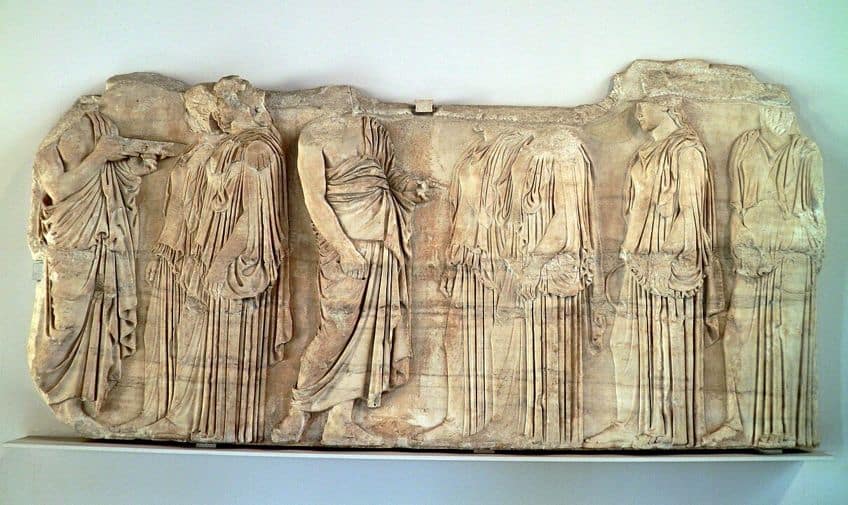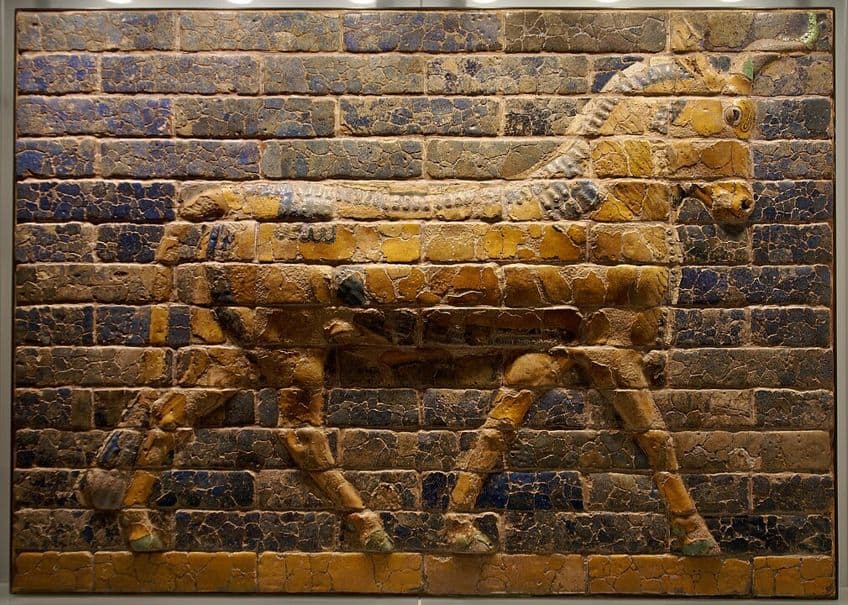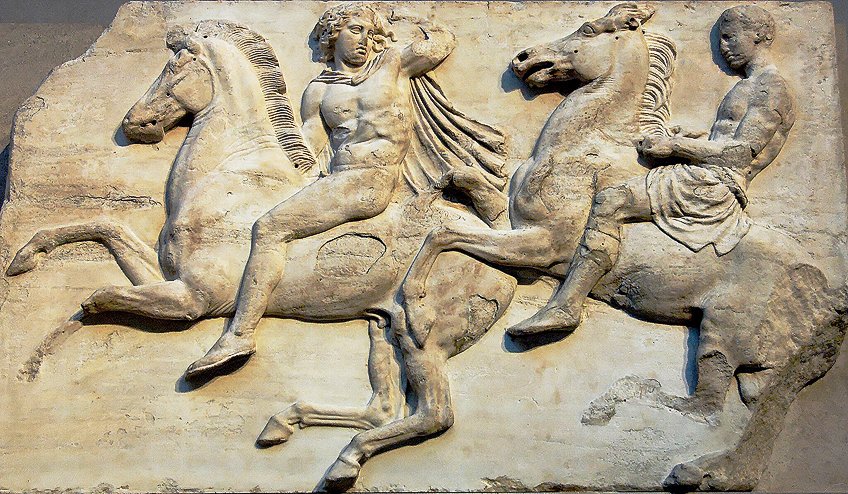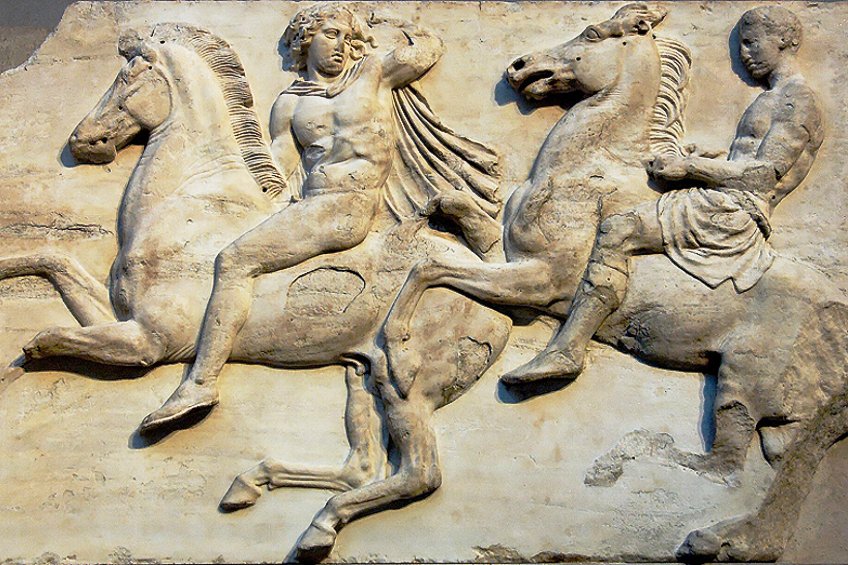Relief Sculpture – Carving Dimensions in Art
What is a high-relief sculpture, and how did this type of sculpture emerge in history? Relief sculptures are best understood as representations or abstract sculptures that are shared as an art form across multiple cultures. From delicate incisions to reliefs that slightly project from their base, relief sculptures have much to teach us about how artists from the past used the natural lay of the land to create many famous relief works of art. In this article, we will introduce you to the history of relief sculpture, including the different types of relief sculptures and a short list of the world’s most famous relief sculptures. Read on to discover more about the origin of relief sculpture!
Table of Contents
- 1 What Is Relief Sculpture?
- 2 Types of Relief Sculpture
- 3 A History of Relief Sculptures
- 4 The Top Five Most Famous Relief Sculptures in the World
- 4.1 Ramesses II Presenting the Temple to Amun-Re; Hypostyle Hall (c. 2055 BCE – 100 CE) by Unknown Sculptors
- 4.2 The Processional Way; Ishtar Gate (c. 575 BCE) by Unknown Sculptor
- 4.3 Parthenon Frieze (c. 443 – 437 BCE) by Phidias
- 4.4 Confederate Memorial Carving (c. 1923 – 1972) by Gutzon Borglum, Augustus Lukeman, and Walker Kirkland Hancock
- 4.5 Mount Rushmore National Memorial (1941) by Gutzon Borglum and Lincoln Borglum
- 5 Frequently Asked Questions
What Is Relief Sculpture?
In visual art, sculpture exists as a useful art form from which we can study moments of the past that artists drew inspiration from. From scenes of mythology and religious beliefs to historical events, sculptures have captured many iconic visuals in art history. Relief sculpture is one such subcategory of sculpture that is defined by a certain set of characteristics.
While there are many types of relief sculptures, one can pinpoint a general definition to a sculpture that projects from a two-dimensional background in varying degrees.
Many relief sculptures come with extensive histories attached to the Eastern and Western worlds and can date as far back as 20,000 years ago. From the Parthenon Frieze to the artwork on civic buildings, relief sculptures were commissioned and installed for various reasons. So, what is a high relief sculpture, and are there any famous examples of relief works to see today? Below, we will dive into the functions of relief sculptures, as well as the different types of relief sculptures that one can find in art history.
Types of Relief Sculpture
Below are a few common types of relief sculptures that can be found in art history. We have compiled a summary of each type so that you can easily understand the differences between each one and be better equipped to identify the various types of relief sculptures.
- High relief sculpture: This type of relief sculpture is also known as alto relief sculpture and is identified as such when the sculpture is projecting outward by half or more of its circumference from the background it is embedded in. High relief sculptures may be disengaged from the ground and produced in the round.
- Low relief sculpture: This type of relief sculpture refers to artworks that project only slightly outward from the base and is also known as a bas-relief sculpture.
- Sunken relief sculpture: The sunken relief sculpture is also identified as an intaglio relief or coelanaglyphic relief, which is characterized by the placement of the carving that lies below the plane of the surrounding surface. The carving is contained within an incised contour line, which frames it with a strong shadow line while the surrounding surface is untouched and has no projections. These types of relief sculptures are best examined in the works of ancient Egyptian sculptures as well as Indian ivory reliefs.
- Statiacciato relief sculpture: This relief sculpture is a flatter low relief sculpture that is more subtle in appearance and is strongly associated with the work of Donatello. The work is subtly carved in relief with finely engraved designs and is best highlighted with particular lighting.

The Function and Significance of Relief Sculptures
What is the purpose of relief sculptures? In history, relief sculptures have long been used as ancient art forms for telling stories about events in the past. Some relief sculptures were created for funerary purposes while others were simply commemorative sculptures for outdoor decoration.
Relief sculptures were also commissioned for private patrons, who wished to have their portraits immortalized in stone, along with their favorite scenes from mythology sculpted into permanent buildings.
A History of Relief Sculptures
Whether it was a scene from the bible, popular literature, mythology, or history, relief sculptures conveyed cultural narratives and histories that would become important study points for later scholars and archaeologists. The progression of relief sculpture over time can be traced by looking at its constant evolution between sculptural and pictorial tendencies. Below, we will now look at the history of relief sculpture, from prehistoric relief works to Renaissance relief works.

Relief Sculpture in Prehistory
Since the Upper Paleolithic era, relief sculptures have been traced back to 25,000 BCE in the cave art of early Europeans in France. One of the earliest relief sculptures was dated to 23,000 BCE and is known as the Venus of Laussel. This relief sculpture depicts a female figure and was discovered in Dordogne in a limestone bas-relief style.
Throughout the Solutrean and Magdalenian eras, relief sculpture have been found in many unique archaeological sites across Europe, including sites in Russia and numerous incised megaliths dating back to the Neolithic period.
Relief Sculpture in Ancient Civilizations
Between 3,500 and 600 BCE, the ancient world had relied on relief sculptures to depict their cultural beliefs and document historical figures and events. Relief sculptures were commonly found on stone facades and important historical architecture across Assyria, Egypt, and many Middle Eastern countries. One of the best examples of relief sculpture was found in Mesopotamian society with the Ishtar Gate, which depicted a set of lions with dragons in a low relief style. Assyrian art showcased their relief sculpture approaches in carvings depicting lion hunt scenes and dating between 1500 and 612 BCE.

In Egypt, sculptors specializing in relief sculpture worked in sunken relief on the Temple of Karnak while the Eastern regions in China worked primarily in low relief. It was not until 500 BCE and onwards that high relief sculptures soared in popularity under the teachings of Greek artisans. Classical antiquity provided more room for exposing artists to high-relief sculpture techniques, many of which can be seen in decorative sculptures and Hellenistic reliefs from around 241 BCE. In early Christian art, relief sculptures also dominated the funerary tombs and sarcophagi of rich believers between the 2nd and the 3rd centuries. Within diasporas of the Mexican pre-Hispanic cultures, as well as the Islamic and Viking groups also produced relief sculptures between 600 and 1100 CE.
Medieval Relief Architecture
In Medieval Europe, relief architecture dominated Christian society as an art form that was installed most notably within cathedrals and churches across Rome. These reliefs were usually sponsored by the Church of Rome and included statuary and reliefs that emphasized Gothic traditions in sculpture. These reliefs decorated the portals of Romanesque churches across Germany, France, and many other European countries. Gothic art had a huge influence on architecture and its role in Christian institutions.
Gothic artists worked in high relief methods closer to the 14th century as the preferences in statuary sculpture shifted.
Relief Sculpture in the Renaissance
Between the 15th and the 17th centuries, Renaissance relief sculptures emerged most notable in the work of Italian artists like Lorenzo Ghiberti, whose renowned bronze doors for the Baptistry of Florence Cathedral drew a great deal of attention. Other sculptors of the Renaissance included Donatello, whose development of low relief sculpture brought a new level of contrasting qualities to texture and surface quality. Many Renaissance sculptors thus maximize their potential for depicting three-dimensional figures on a two-dimensional surface, with slight exceptions in trendsetters like Desiderio da Settignano and Michelangelo. A few important artists working in relief sculpture from the 16th century school known as the Fontainebleau School included Rosso Fiorentino and Francesco Primaticcio, both of whom contributed to the legacy of the school renowned for its “fantastic” stucco relief sculptures.

With the rise of Baroque art styles, relief sculpture took a more pictorial approach and saw an increase in scale. Relief sculptures took on the compositional qualities of large-scale paintings sculpted from marble. Important figures such as Antonio Canova and Gian Lorenzo Bernini were considered masters of relief sculpture and who skillfully executed their compositions in the signature pictorial-style of the Renaissance. This continued on throughout the 19th century with works produced by artists such as Auguste Rodin and Francois Rude.
Relief Sculpture in the United States
The introduction of relief sculpture in the United States was led by Italian artists who were commissioned to decorate government buildings in the 19th century. This influenced American sculptors to develop relief sculpture through the works of figures like Edward Sheffield Bartholomew and Thomas Crawford, along with many others who replicated such styles with a focus on idealized forms and portraits to cater for a global market.
As the focus shifted toward idealized figures in sculpture, relief sculpture took somewhat of a backseat, however, it was not long before the works of Neoclassical sculptors influenced the American sculptors.
Erastus Dow Palmer was one such American sculptor who embraced the styles of Neoclassical art and created many idealized subjects in his reliefs. Henry Kirke Brown is another famous American sculptor who used his knowledge from Italian academia to create a shift toward Naturalism in American relief sculpture, as well as the transition from marble to bronze. A few other influential sculptors include Augustus Saint-Gaudens, Olin Levi Warner, and Daniel Chester French.
The Top Five Most Famous Relief Sculptures in the World
Now that you have an informed understanding of the history of relief sculpture and the many talented and influential artists who shaped it, you can now appreciate a review of the five most famous relief sculptures in the world. Hopefully, you will be inspired to try your hand at relief sculpture and test the boundaries of your sculptural practice!
Ramesses II Presenting the Temple to Amun-Re; Hypostyle Hall (c. 2055 BCE – 100 CE) by Unknown Sculptors
| Artist Name | Unknown sculptors |
| Date | c. 2055 BCE – 100 CE |
| Medium | Sandstone sunken relief sculptures |
| Dimensions (cm) | Unavailable |
| Where It Is Housed | The Karnak Temple Complex, Luxor, Egypt |
Sculpted by many unknown sculptors, the famous Hypostyle Hall from the temple of Karnak in Luxor, Egypt is one of the most fascinating and popular sites for exploring sunken relief sculpture. With numerous reliefs to marvel at, the hall is located in the birthplace of creation according to the Egyptian belief system and is the site where the Egyptian people met with the god Amun-Ra.
This historical place of worship is home to many detailed carvings and sunken reliefs that showcase the cultural practices and ceremonies of past peoples. The temples houses artworks that were created by famous pharaohs such as Seti I, Hatshepsut, Ramses II, and Thutmose III with a construction period of around 1,500 years in the making. The Karnak complex offers much insight into the ancient Egyptian religion and can be spotted in the relief of Ramesses II Presenting the Temple to Amun-Re. This scene is part of a series of long ritual acts that span several episodes and features Ramesses II enacting various rites to build and present the temple to the god.
The Processional Way; Ishtar Gate (c. 575 BCE) by Unknown Sculptor
| Artist Name | Unknown sculptors |
| Date | c. 575 BCE |
| Medium | Pressed clay bricks with lapis lazuli glazing |
| Dimensions (cm) | 1402 x 3048 |
| Where It Is Housed | Metropolitan Museum of Art in New York, United States, Istanbul Archaeological Museums in Istanbul, Türkiye, the Pergamon Museum in Berlin, Germany, and other art institutions around the world |
Recognized as The Processional Way, the high relief sculptures from the Ishtar Gate is among the most famous relief sculptures in the world that are associated with a historical Neo-Babylonian Empire ruled by King Nebuchadnezzar II. It is believed that the king commissioned the sculpture to be decorated with brick reliefs with motifs of lions as a dedicated artwork to the goddess known as Ishtar or Inanna. Other motifs such as dragons were made to honor the national god Marduk, as well as other gods. On the north side of the gate, a roadway was constructed with striding lions, which were created in relief and was a symbol of protection for the area. This repetitive design was significant to the ritualistic processions that took place from the city to the temple. Today, many reliefs of the gate is scattered in museums around the world.

Parthenon Frieze (c. 443 – 437 BCE) by Phidias
| Artist Name | Phidias (c. 488 – 430 BCE) |
| Date | c. 443 – 437 BCE |
| Medium | Pentelic marble |
| Dimensions (cm) | 15971.5 x 100 |
| Where It Is Housed | British Museum, London, United Kingdom, and the Acropolis Museum, Athens, Greece |
This renowned high and low-relief marble sculpture is recognized as the most famous work of Phidias, who was a well-known 5th century artist and architect. The Parthenon Frieze was created as a decorative piece for the naos section of the Parthenon’s façade. While parts of the sculpture is located in the British Museum in London, the majority of the frieze can be found in the Acropolis Museum in Athens.
Today, the sculpture is widely celebrated as a masterpiece of Attic sculpture, which floats between the styles of the Late Classical rich style and the Severe style reminiscent of the period it was produced (c. 443 – 437 BCE).
The frieze itself, which ran along the four sides of the building, was sculpted in low relief while the metopes were created in high relief. The Acropolis Museum also houses another famous relief sculpture of an ear from the 4th century, which garnered much mystery and attention around its origins and purpose. Other interesting relief sculptures you can explore further include the Pergamon Altar (c. 2nd century), Paleolithic era relief sculptures at the Roc de Sers cave in France, and Arjuna’s Penance in Mahabalipuram, India.

Confederate Memorial Carving (c. 1923 – 1972) by Gutzon Borglum, Augustus Lukeman, and Walker Kirkland Hancock
| Artist Name | Gutzon Borglum (1867 – 1941), Augustus Lukeman (1872 – 1935), and Walker Kirkland Hancock (1901 – 1998) |
| Date | c. 1923 – 1972 |
| Medium | Granite high relief sculpture |
| Dimensions (cm) | 2743.2 x 5791.2 x 1280.16 |
| Where It Is Housed | Stone Mountain, Georgia, United States |
The Confederate Memorial Carving is among the most famous high relief sculptures in the world that is also recognized as the largest of its kind. The sculpture depicts the three main pioneers of the Civil War; Thomas J. “Stonewall” Jackson, President Jefferson Davis, and Generals Robert E. Lee. The sculpture itself is larger than a football field and spans approximately three acres and is 400 feet off the ground. The figures were sculpted by three sculptors, namely, Gutzon Borglum, Augustus Lukeman, and Walker Kirkland Hancock. The finer details on the granite structure were achieved using a small thermo-jet torch to carve out the eyebrow hairs, buckles, and fingers.

Mount Rushmore National Memorial (1941) by Gutzon Borglum and Lincoln Borglum
| Artist Name | Gutzon Borglum (1867 – 1941) and Lincoln Borglum (1912 – 1986) |
| Date | 1941 |
| Medium | Granite high-relief sculpture |
| Dimensions (cm) | 1828.8 x 640 |
| Where It Is Housed | Mount Rushmore, Keystone, United States |
The Mount Rushmore National Memorial is the most famous high-relief sculpture in the United States and is also one of the country’s biggest tourist attractions. The historical sculpture saw its construction begin around 1927 and completed by 1941, in the same year as the death of one of its sculptors, Gutzon Borglum. The massive sculpture can be spotted on the façade of the Mount Rushmore mountain located in Black Hills in South Dakota and was co-completed by Borglum’s son Lincoln Borglum.

The granite sculpture portrays the portraits of four United States’ presidents; George Washington, Thomas Jefferson, Theodore Roosevelt, and Abraham Lincoln, as well as an attempted fifth face of Benjamin Black Elk, which occurred between the 1950s and 1960s. The iconic sculpture was created at approximately 5,725 feet above sea level and was given its name “Mount Rushmore” back in 1885, after Charles E. Rushmore, an attorney from New York. What does the sculpture mean? The American presidents symbolize the promise of democracy in America and reflect its history, shaped by the four presidents. The site also hosts the studio of the sculptors, including a museum, hiking trails, and many other activities.
Creating a relief sculpture is no easy feat, whether it is a sunken relief or a high relief; one can quickly grasp the amount of effort and planning it takes to produce such monumental and detailed relief sculptures. By learning more about the famous relief sculptures in the world and the many types of relief sculptures, you can learn to appreciate the medium of sculpture as more than a decorative artwork.
Frequently Asked Questions
What Is Relief Sculpture?
In sculpture, relief artworks are described as any sculpted form that is carved into an even plane or base, where the plane is removed to produce an image or artwork without completely disconnecting the work from the base. These types of sculptures are not freestanding works or works produced in the round, and are characterized by a background from which the main subjects emerge.
What Are the Different Types of Relief Sculpture?
There are many different types of relief sculpture. These include high relief, bas-relief, sunken relief, and statiacciato relief sculpture. These types of relief sculptures have been practiced and refined for centuries across many older civilizations and cultures around the world.
What Is the Most Famous Relief Sculpture of the 20th Century?
The Mount Rushmore National Memorial is recognized as the most famous high relief sculpture of the 20th century. It was completed by Gutzon Borglum and his son in 1941, and is best-known for its depiction of the four most famous United States presidents.
What Is the Largest Relief Sculpture in the World?
The Confederate Memorial Carving on Stone Mountain in Georgia is regarded as the world’s largest relief sculpture that was created between 1923 and 1972 by three different sculptors. The sculpture is recognized as an example of high relief sculpture and is larger than a football field, measuring around three acres in length and 400 feet off the ground. A few famous examples of relief in architecture can be seen in the Florence Baptistery in Italy, and the temple Borobudur in Central Java, Indonesia.
What Is a Relief in Architecture?
Relief sculptures in architecture have historically been connected to artworks that were created on the walls of buildings and their facades for decorative functions. Reliefs in architecture are created to narrate relevant stories to the building’s history or location’s culture. It is most commonly associated with Gothic architecture, as well as Romanesque architecture, and Greek and Roman art.
Jordan Anthony is a film photographer, curator, and arts writer based in Cape Town, South Africa. Anthony schooled in Durban and graduated from the University of the Witwatersrand, Johannesburg, with a Bachelor of Art in Fine Arts. During her studies, she explored additional electives in archaeology and psychology, while focusing on themes such as healing, identity, dreams, and intuitive creation in her Contemporary art practice. She has since worked and collaborated with various professionals in the local art industry, including the KZNSA Gallery in Durban (with Strauss & Co.), Turbine Art Fair (via overheard in the gallery), and the Wits Art Museum.
Anthony’s interests include subjects and themes related to philosophy, memory, and esotericism. Her personal photography archive traces her exploration of film through abstract manipulations of color, portraiture, candid photography, and urban landscapes. Her favorite art movements include Surrealism and Fluxus, as well as art produced by ancient civilizations. Anthony’s earliest encounters with art began in childhood with a book on Salvador Dalí and imagery from old recipe books, medical books, and religious literature. She also enjoys the allure of found objects, brown noise, and constellations.
Learn more about Jordan Anthony and the Art in Context Team.
Cite this Article
Jordan, Anthony, “Relief Sculpture – Carving Dimensions in Art.” Art in Context. January 12, 2024. URL: https://artincontext.org/relief-sculpture/
Anthony, J. (2024, 12 January). Relief Sculpture – Carving Dimensions in Art. Art in Context. https://artincontext.org/relief-sculpture/
Anthony, Jordan. “Relief Sculpture – Carving Dimensions in Art.” Art in Context, January 12, 2024. https://artincontext.org/relief-sculpture/.











